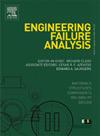裂纹对钢/铝SPR接头失效机制、力学性能和疲劳行为的影响
IF 5.7
2区 工程技术
Q1 ENGINEERING, MECHANICAL
引用次数: 0
摘要
在现代汽车工业中,轻量化是一个主要的发展趋势,钢和铝等异种材料的连接已成为车身结构的关键解决方案。自穿孔铆接(SPR)在异种材料的连接中有着广泛的应用,具有稳定的接头强度和疲劳性能。然而,当基材伸长率较低时,SPR接头可能出现裂纹。本文选用22MnB5钢和AL6061-T6铝作为连接材料。通过断面分析和金相观察,探讨了SPR接头颈部和头部裂纹的形成机理。结果表明,减小模具深度可有效抑制SPR接头的裂纹萌生。剪切试验表明,颈部裂纹显著降低了SPR节点的强度。在此基础上,对有无头部裂纹的SPR接头进行了疲劳试验,并对其疲劳断口进行了分析。结果表明,头部裂纹对疲劳性能的影响可以忽略不计,两种类型的疲劳寿命相当。本文章由计算机程序翻译,如有差异,请以英文原文为准。
The effects of cracks on the failure mechanisms, mechanical properties, and fatigue behaviors of steel/aluminum SPR joints
In the modern automotive industry, lightweighting is a major development trend, and the joining of dissimilar materials like steel and aluminum has become a key solution for vehicle body structures. Self-piercing riveting (SPR) is widely applied in joining dissimilar materials, offering stable SPR joint strength and fatigue performance. However, when the base materials exhibit low elongation, cracks may in SPR joints. In this paper, 22MnB5 steel and AL6061-T6 aluminum were selected as the joining materials. The mechanisms of neck and head crack formation in SPR joints were investigated through cross-sectional analysis and metallographic observation. The results show that reducing the die depth effectively suppresses crack initiation in SPR joints. Shear tests revealed that neck cracks significantly reduce the SPR joint strength. Furthermore, fatigue tests were carried out on SPR joints with and without head cracks, and the fatigue fracture surfaces were analyzed. The results indicate that head cracks have a negligible influence on fatigue performance, with both types exhibiting comparable fatigue life.
求助全文
通过发布文献求助,成功后即可免费获取论文全文。
去求助
来源期刊

Engineering Failure Analysis
工程技术-材料科学:表征与测试
CiteScore
7.70
自引率
20.00%
发文量
956
审稿时长
47 days
期刊介绍:
Engineering Failure Analysis publishes research papers describing the analysis of engineering failures and related studies.
Papers relating to the structure, properties and behaviour of engineering materials are encouraged, particularly those which also involve the detailed application of materials parameters to problems in engineering structures, components and design. In addition to the area of materials engineering, the interacting fields of mechanical, manufacturing, aeronautical, civil, chemical, corrosion and design engineering are considered relevant. Activity should be directed at analysing engineering failures and carrying out research to help reduce the incidences of failures and to extend the operating horizons of engineering materials.
Emphasis is placed on the mechanical properties of materials and their behaviour when influenced by structure, process and environment. Metallic, polymeric, ceramic and natural materials are all included and the application of these materials to real engineering situations should be emphasised. The use of a case-study based approach is also encouraged.
Engineering Failure Analysis provides essential reference material and critical feedback into the design process thereby contributing to the prevention of engineering failures in the future. All submissions will be subject to peer review from leading experts in the field.
 求助内容:
求助内容: 应助结果提醒方式:
应助结果提醒方式:


